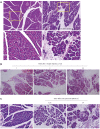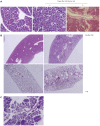Antioxidative phytoceuticals to ameliorate pancreatitis in animal models: an answer from nature
- PMID: 25469025
- PMCID: PMC4248200
- DOI: 10.3748/wjg.v20.i44.16570
Antioxidative phytoceuticals to ameliorate pancreatitis in animal models: an answer from nature
Abstract
Despite enthusiastic efforts directed at elucidating critical underlying mechanisms towards the identification of novel therapeutic targets for severe acute pancreatitis (SAP), the disease remains without a specific therapy to be executed within the first hours to days after onset of symptoms. Although earlier management for SAP should aim to either treat organ failure or reduce infectious complications, the current standard of care for the general management of AP in the first hours to days after onset of symptoms include intravenous fluid replacement, nutritional changes, and the use of analgesics with a close monitoring of vital signs. Furthermore, repeated evaluation of severity is very important, as the condition is particularly unstable in the early stages. In cases where biliary pancreatitis is accompanied by acute cholangitis or in cases where biliary stasis is suspected, an early endoscopic retrograde cholangiopancreatography is recommended. However, practice guidelines regarding the treatment of pancreatitis are suboptimal. In chronic pancreatitis, conservative management strategies include lifestyle modifications and dietary changes followed by analgesics and pancreatic enzyme supplementation. Recently, attention has been focused on phytoceuticals or antioxidants as agents that could surpass the limitations associated with currently available therapies. Because oxidative stress has been shown to play an important role in the pathogenesis of pancreatitis, antioxidants alone or combined with conventional therapy may improve oxidative-stress-induced organ damage. Interest in phytoceuticals stems from their potential use as simple, accurate tools for pancreatitis prognostication that could replace older and more tedious methods. Therefore, the use of antioxidative nutrition or phytoceuticals may represent a new direction for clinical research in pancreatitis. In this review article, recent advances in the understanding of the pathogenesis of pancreatitis are discussed and the paradigm shift underway to develop phytoceuticals and antioxidants to treat it is introduced. Despite the promise of studies evaluating the effects of antioxidants/phytoceuticals in pancreatitis, translation to the clinic has thus far been disappointing. However, it is expected that continued research will provide solid evidence to justify the use of antioxidative phytoceuticals in the treatment of pancreatitis.
Keywords: Acute pancreatitis; Antioxidants; Chronic pancreatitis; Phytoceuticals; Severe acute pancreatitis.
Figures



References
Publication types
MeSH terms
Substances
LinkOut - more resources
Full Text Sources
Other Literature Sources
Medical
Miscellaneous

